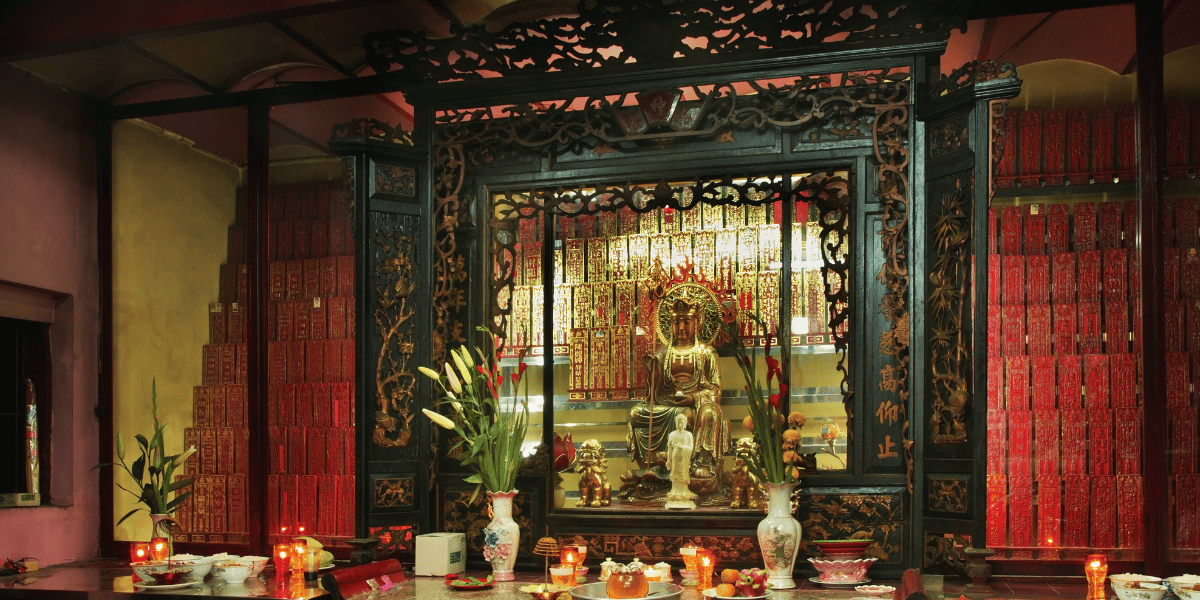The Temple of Literature: A Journey Through Vietnam’s Cultural and Educational Heritage
Last Updated on 12 August, 2024 by admin
The Temple of Literature (Văn Miếu – Quốc Tử Giám) is one of Vietnam’s most iconic cultural and educational landmarks, symbolising the nation’s long-standing reverence for learning and scholarship. Located in the heart of Hanoi, this historic site was established in 1070 during the Lý Dynasty and served as Vietnam’s first national university. Its unique architecture, which blends traditional Vietnamese design with Confucian elements, stands as a testament to the enduring value of education in Vietnamese society. The Temple of Literature not only honours Confucius and scholars of the past but also reflects the deep-rooted tradition of valuing knowledge and academic achievement that has been a cornerstone of Vietnamese culture for centuries.
History of Formation and Development
The Temple of Literature (Văn Miếu) was founded in 1070 by King Lý Thánh Tông, who ordered its construction to honour Confucius and other revered sages. This site quickly became a symbol of intellectual and moral cultivation in Vietnam. In 1076, just a few years after the temple’s establishment, the Quốc Tử Giám was founded adjacent to Văn Miếu, marking the birth of Vietnam’s first national university. Quốc Tử Giám was initially reserved for members of the royal family and the elite, but it gradually opened its doors to talented students from across the country, further solidifying its role as a centre of higher learning.

Throughout its history, Văn Miếu – Quốc Tử Giám underwent several significant developments. During the Trần Dynasty, the complex was expanded and enhanced, reflecting the growing importance of Confucian education in Vietnamese society. The most notable development occurred during the Lê Dynasty, when the tradition of erecting stone steles (bia Tiến sĩ) began. These steles, inscribed with the names and achievements of those who passed the imperial examinations, were erected to honour Vietnam’s scholars and preserve their legacies for future generations. This practice not only celebrated academic success but also encouraged the pursuit of knowledge and excellence.
During the Nguyễn Dynasty, when the capital was moved to Huế, a new Văn Miếu was constructed there. However, the original Temple of Literature in Hanoi continued to be preserved and maintained, reflecting its enduring significance as a symbol of Vietnam’s educational and cultural heritage. Despite the shift in the political centre, Văn Miếu – Quốc Tử Giám in Hanoi remained a revered site, embodying the deep respect for education and intellectual achievement that has characterised Vietnamese society for centuries.
Architecture and Space
The Temple of Literature (Văn Miếu – Quốc Tử Giám) in Hanoi is a masterpiece of traditional Vietnamese architecture, reflecting the harmony between cultural significance and natural beauty. As you enter the site, you are greeted by the Văn Miếu Gate, the grand and imposing main entrance that sets the tone for the sacred and scholarly atmosphere within. This gateway, with its intricate carvings and robust structure, symbolises the threshold between the outside world and the revered grounds dedicated to Confucian learning and wisdom.
Inside the complex, the spacious courtyard offers a serene environment, filled with lush greenery and tranquil ponds. The peaceful setting is designed to evoke a sense of calm and contemplation, making it an ideal environment for study and reflection. The presence of many ancient trees, coupled with the carefully maintained gardens, contributes to the overall sense of tranquility that permeates the entire site.
The Đại Thành Môn, the second gate within the complex, leads to the heart of the Temple of Literature. This gateway serves as a symbolic passage into the core of the scholarly world, where the legacy of Confucius and his disciples is honoured. As you pass through this gate, you are drawn further into the sacred space where education and reverence for knowledge have been upheld for centuries.

One of the most iconic structures within the Temple of Literature is the Khuê Văn Các, an elegant eight-roofed pavilion that has become the symbol of this historic site. Built in 1805 during the Nguyễn Dynasty, Khuê Văn Các represents the beauty and purity of the Confucian spirit. Its unique architectural style, with intricate wooden carvings and a distinctive red colour, captures the essence of traditional Vietnamese aesthetics and is often used as an emblem of Hanoi’s cultural heritage.
The Thiên Quang Well, located within the complex, is another significant feature. This clear, reflective pool is believed to bring good fortune to scholars and students who visit. The well’s water is said to mirror the sky, symbolising the connection between the heavens and the pursuit of knowledge.
Adjacent to the well is the Doctor’s Stelae Courtyard, where 82 stone stelae, or bia Tiến sĩ, are carefully preserved. These stelae are engraved with the names and achievements of scholars who passed the rigorous imperial examinations from 1442 to 1779. Each stone, resting on the back of a stone tortoise, a symbol of longevity and wisdom, serves as a lasting tribute to Vietnam’s scholarly elite and a reminder of the country’s rich academic traditions.
At the centre of the complex is the Đại Bái Đường, the main hall where Confucius and other revered sages are worshipped. This grand hall, with its solemn atmosphere and rich decorations, is the spiritual heart of the Temple of Literature. It is here that offerings and ceremonies are held to honour the contributions of Confucius and his followers to Vietnamese education and moral philosophy.
Lastly, the Thái Học Courtyard, originally the site of the Quốc Tử Giám (Vietnam’s first university), now houses a variety of educational exhibits and cultural activities. This area once served as the central hub for learning and teaching, where Vietnam’s brightest minds were nurtured. The preservation of this space continues to inspire a deep respect for education and intellectual achievement among visitors today.
The architecture and layout of the Temple of Literature not only showcase Vietnam’s traditional design but also embody the nation’s long-standing commitment to learning and scholarship. Each structure and space within the complex contributes to the overall narrative of intellectual and cultural reverence, making it a profound and inspiring destination for all who visit.
Cultural and Educational Significance
The Temple of Literature (Văn Miếu – Quốc Tử Giám) holds a profound cultural and educational significance in Vietnam, symbolising the nation’s deep reverence for knowledge and learning. As a site dedicated to honouring Confucius and other esteemed scholars, Văn Miếu stands as a testament to Vietnam’s long-standing tradition of valuing education. It is a place where the achievements of past scholars are celebrated, and the virtues of diligence, perseverance, and respect for learning are upheld. By recognising and venerating the contributions of those who shaped Vietnam’s educational foundations, Văn Miếu continues to inspire younger generations to pursue academic excellence and uphold the country’s scholarly traditions.

In addition to its role in promoting education, the Temple of Literature is a vital cultural heritage site, playing a crucial role in preserving Vietnam’s rich history and traditional values. As one of the oldest and most important historical landmarks in the country, Văn Miếu embodies the architectural and philosophical ideals of its time, offering valuable insights into Vietnam’s cultural evolution. The preservation of this site ensures that future generations can continue to learn about and appreciate the cultural practices, beliefs, and achievements of their ancestors.
Moreover, Văn Miếu has become a major tourist attraction, drawing visitors from both within Vietnam and around the world. Tourists come not only to admire the architectural beauty of the site but also to delve into the history and cultural heritage it represents. Through guided tours and educational exhibits, visitors gain a deeper understanding of Vietnam’s intellectual legacy and the pivotal role that education has played in shaping the nation’s identity. The Temple of Literature serves as a bridge between the past and the present, offering a space where people can connect with the enduring values of knowledge and cultural preservation, making it an essential destination for anyone interested in the history and culture of Vietnam.
Visitor Information
When planning a visit to the Temple of Literature (Văn Miếu – Quốc Tử Giám) in Hanoi, it is essential to be aware of some key logistical details to ensure a smooth and enjoyable experience. The Temple of Literature is located at 58 Quốc Tử Giám Street in the Đống Đa District, a central and easily accessible area of Hanoi. This historic site is not only a cultural landmark but also a tranquil oasis in the bustling city, offering visitors a unique glimpse into Vietnam’s rich educational heritage.
The opening hours of the Temple vary slightly between the summer and winter seasons to accommodate the changing daylight hours. During the summer months, from around May to October, the site is open from 7:30 AM to 5:30 PM, allowing visitors to explore the grounds in the cooler parts of the day. In the winter months, from November to April, the opening hours shift to 8:00 AM to 5:00 PM. This slight adjustment ensures that visitors can still enjoy ample time to explore the site while taking advantage of the best natural lighting.
Regarding entry fees, the Temple of Literature offers affordable rates to encourage a wide range of visitors, including locals, tourists, and students. The general admission fee for adults is 30,000 VND, which provides access to all areas of the complex, including its various pavilions, courtyards, and gardens. For students, a discounted rate of 15,000 VND is available, reflecting the site’s continued commitment to supporting education and learning. Schoolchildren can enter for just 10,000 VND, making it an accessible and educational outing for young learners.
These practical details—address, opening hours, and ticket prices—make it easier for visitors to plan their visit to the Temple of Literature, ensuring they have the opportunity to fully immerse themselves in the history and culture of this iconic site. Whether you are a local resident, a student, or an international traveller, the Temple of Literature offers a profound and enriching experience that is well worth the visit.
Conclusion
The Temple of Literature (Văn Miếu – Quốc Tử Giám) stands as a remarkable testament to Vietnam’s rich historical, cultural, and educational heritage. As a symbol of the nation’s enduring respect for learning and scholarship, it encompasses a range of architectural marvels, from the imposing Văn Miếu Gate to the serene Khuê Văn Các Pavilion, each reflecting the profound significance of knowledge in Vietnamese society. The stelae in the Doctor’s Stelae Courtyard, which immortalise the names of successful scholars, further highlight the importance placed on academic achievement throughout the centuries.
Beyond its architectural beauty, the Temple of Literature holds immense value as a cultural and educational monument. It preserves the legacy of Confucian education in Vietnam, offering visitors a window into the philosophical and moral foundations that have shaped the country. As a historic site, it not only honours the past but also inspires future generations to appreciate and continue the tradition of valuing knowledge and education.
For those seeking to connect with Vietnam’s rich cultural past, a visit to the Temple of Literature is a must. It provides a unique opportunity to experience a space where history, culture, and education converge. We encourage all readers to visit this iconic site, to walk its tranquil courtyards, and to immerse themselves in the cultural atmosphere that has influenced Vietnam for nearly a millennium. The Temple of Literature is more than just a tourist attraction—it is a place where the spirit of learning and cultural reverence is kept alive, offering a profound and enriching experience for all who visit.




